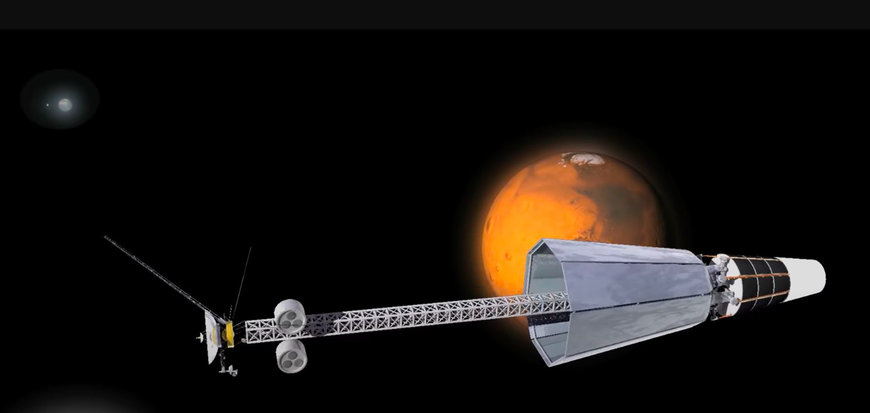www.aero-defence.tech
10
'23
Written on Modified on
Lockheed Martin News
LOCKHEED MARTIN JETS INTO NUCLEAR ELECTRICAL SPACECRAFT POWER
Lockheed Martin was awarded $33.7 million from the Air Force Research Laboratory (AFRL) for the JETSON High Power program to mature high-power nuclear electric power and propulsion technologies and spacecraft design.

Los Alamos National Laboratory’s concept of a space nuclear reactor system to produce high-power electricity. Image credit: LANL
With Space Nuclear Power Corp (SpaceNukes) and BWX Technologies, Inc. (BWXT) as its partners – both of whom carry deep expertise in nuclear power and reactor design – Lockheed Martin's Joint Emergent Technology Supplying On-Orbit Nuclear (JETSON) team will address the escalating need for advanced spacecraft mobility, situational awareness, and power generation that far surpasses traditional spacecraft capabilities. Providing both on-board electrical power and the ability to power electric propulsion Hall thrusters used on Lockheed Martin’s LM2100 satellites, JETSON serves as a critical step forward in using nuclear electric propulsion to get humans to the Moon, Mars and beyond.
The JETSON effort is now in the preliminary design review stage, with the option to go to the critical design review level.
Nuts and Bolts
JETSON will use a fission reactor that generates heat, which is then transferred to Stirling engines to produce between 6 kWe and 20 kWe of electricity – four times the power of conventional solar arrays without the need to be in continuous sunlight. The reactor draws heavily from the design and lessons of the 2018 Kilopower Reactor Using Stirling Technology (KRUSTY) demonstration led by NASA and the DoE’s National Nuclear Security Administration.
This technology has the potential to produce much higher electrical output than spacecraft powered by solar panels, which generally garner about 600 watts of power, or the equivalent of six lightbulbs. For deep space exploration missions not as close to the sun, or in shadowed regions, nuclear electric-powered subsystems are a great alternative to have in a company’s power-generation toolkit.
Safety First
As on other space nuclear programs, safety is a top priority with JETSON. Uranium, prior to the start of the fission process, is benign. During launch, the reactor is in an inert, inactive configuration and is designed to not turn on and start the fission process until the spacecraft is in a safe non-decaying orbit far out from Earth.
The development work will be done across the country including at Lockheed Martin’s facility near Denver, at AFRL’s facility in Albuquerque, New Mexico, at SpaceNukes’ facility at Los Alamos, New Mexico and at BWXT in Lynchburg, Virginia. Several New Mexico-based national labs, facilities and suppliers will also support.
With Space Nuclear Power Corp (SpaceNukes) and BWX Technologies, Inc. (BWXT) as its partners – both of whom carry deep expertise in nuclear power and reactor design – Lockheed Martin's Joint Emergent Technology Supplying On-Orbit Nuclear (JETSON) team will address the escalating need for advanced spacecraft mobility, situational awareness, and power generation that far surpasses traditional spacecraft capabilities. Providing both on-board electrical power and the ability to power electric propulsion Hall thrusters used on Lockheed Martin’s LM2100 satellites, JETSON serves as a critical step forward in using nuclear electric propulsion to get humans to the Moon, Mars and beyond.
The JETSON effort is now in the preliminary design review stage, with the option to go to the critical design review level.
Nuts and Bolts
JETSON will use a fission reactor that generates heat, which is then transferred to Stirling engines to produce between 6 kWe and 20 kWe of electricity – four times the power of conventional solar arrays without the need to be in continuous sunlight. The reactor draws heavily from the design and lessons of the 2018 Kilopower Reactor Using Stirling Technology (KRUSTY) demonstration led by NASA and the DoE’s National Nuclear Security Administration.
This technology has the potential to produce much higher electrical output than spacecraft powered by solar panels, which generally garner about 600 watts of power, or the equivalent of six lightbulbs. For deep space exploration missions not as close to the sun, or in shadowed regions, nuclear electric-powered subsystems are a great alternative to have in a company’s power-generation toolkit.
Safety First
As on other space nuclear programs, safety is a top priority with JETSON. Uranium, prior to the start of the fission process, is benign. During launch, the reactor is in an inert, inactive configuration and is designed to not turn on and start the fission process until the spacecraft is in a safe non-decaying orbit far out from Earth.
The development work will be done across the country including at Lockheed Martin’s facility near Denver, at AFRL’s facility in Albuquerque, New Mexico, at SpaceNukes’ facility at Los Alamos, New Mexico and at BWXT in Lynchburg, Virginia. Several New Mexico-based national labs, facilities and suppliers will also support.
www.lockheedmartin.com

